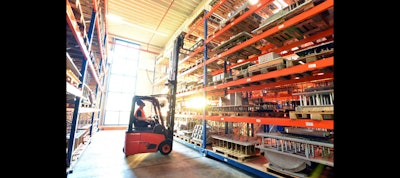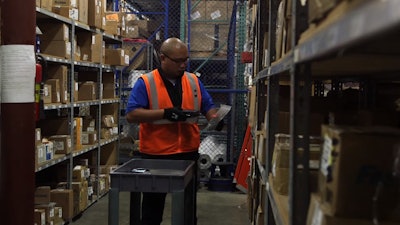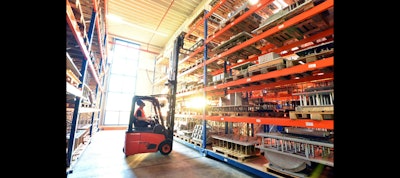
View part 1 of this article here.
When most people think of risky jobs, names like Jim Cantore or Bear Grylls frequently come to mind. But ironically, warehousing professionals are just as likely to get hurt as many of the daredevils you see on television. And the logistics industry has the injury rates to prove it.
However, that doesn’t mean your company’s warehouses have to be substantial contributors to these negative statistics — because as the following Alphabet Of Warehouse Safety suggests, there are many ways ranging from the simple to the strategic that your company can do a better job of keeping its warehouse employees as safe and safety-minded as possible.
Negative thinking
If your company steadfastly refuses to focus time or attention on recent accidents because it only wants to accentuate the positive, it’s overlooking a prime opportunity to take its safety program to the next level. Every time one of your employees has an accident, it poses a significant opportunity to review what happened with your other employees. Not only will it make the issue of safety more real to them, it will have an impact that hypothetical examples can’t even begin to touch.
Opening one truck door at a time
No matter how well freight has been secured by stretch wrap, straps or other methods, the contents of some trucks occasionally can — and do — fall on the people assigned to unload them. To help avoid these painful mishaps, think about introducing a firm policy of having employees open just one truck door at a time — and standing behind it as they do — when shipments arrive. It’s also wise to require them to wear protective clothing such as hard hats and steel-toed boots any time they’re on the job.
Pedestrian safety training
Forklift operators may be the ones in the driver’s seat. But careless pedestrian behaviors like hitching a ride, walking underneath a working vehicle or getting in the way of a vehicle and its load can also be a prime cause of industrial equipment accidents and injuries. Make sure all of your employees — and not just your equipment operators — are fully trained in forklift safety. Just as important, ensure that your pedestrian employees understand that even though drivers are trained to be mindful of their safety, that’s no excuse for being careless or creating a hazard themselves.

Quick clean-ups
Whether they’re large or small, puddles or drips can be a major source of painful slips, trips or falls. So if something leaks or spills on your facility’s loading dock, trailers or storage areas, get it cleaned up and dried immediately if you can — or mark off the area and put up warning cones or signs until it can be tended to.
Reflection
Never underestimate the analytical value of an accident that occurs at your facility. By carefully reviewing what happened and taking the time to identify its root cause, your organization can determine if there was an unsafe process involved and take steps to correct it company-wide, thus helping to prevent similar accidents.
Supervisor buy-in
Out of all the employees who need to get on board with a warehouse safety effort, supervisors are often among the most difficult and important to win over, because they’re usually the personnel who are under the most pressure to deliver and produce. With this in mind, it’s always wise to spend some time educating them about how extra safety precautions will actually enhance rather than undermine their facilities’ productivity. It also doesn’t hurt to put some safety measures into their bonus or incentive packages.
Table safety
Approximately 80 percent of us are likely to experience back pain in our lives, and awkward postures such as those routinely adopted at work tables are a key contributor. In light of that, make sure your warehouses’ work table heights allow employees to work with their hands and arms at or above elbow level (usually somewhere between 34 and 38 inches, although it all depends on peoples’ heights). Or consider using work surfaces that have cut-outs.
Updated training
The logistics industry has a high rate of turnover, which means that no matter how frequently and diligently you provide safety training sessions at each of your company’s distribution centers, there will almost always be some personnel who didn’t receive that instruction the first time around. Just as important, even the best of supply chain professionals occasionally require some safety re-education. Make sure you’re scheduling frequent safety training sessions at each of your company’s warehouse locations — and by frequent, that means more than just what’s required to meet the OSHA-mandated minimum.

Variation
One of the largest threats to the efficacy of any safety program — but particularly a well-established one — is the possibility of message fatigue. Aim to diversify your education and messaging via a combination of everything from classroom instruction and manuals to videos, e-mails, web sites, visual displays and some of the lighter-hearted materials already mentioned. It will help you re-communicate some of the most essential safety policies or tips as often as needed without seeming repetitive.
Walkie-talkies
Pedestrians and trucks aren’t always a good mix, especially when the latter are pulling into or out of your operation. Rather than having your facility’s yard safety personnel walk to and from trucks every time they need to talk with a parked driver, encourage them to use walkie-talkies or cell phones instead. It will help reduce unnecessary foot traffic in your truck yards.
X-ternal resources
If your company’s safety funding is limited, consider asking for instructional help from forklift manufacturing companies or consultant resources. Many have developed excellent training programs. Or consider asking one of your workers’ compensation insurance companies to develop some sort of training program for you. (After all, it’s in their best interest to help reduce your company’s injuries, too.) OSHA’s consulting division may also point you in the direction of some economical but highly effective tools.
Yard safety measures
Besides walkie-talkies, there are several other highly useful practices that can go a long way toward ensuring your yard personnel and the trucks they’re helping to direct steer clear of one another. These include instructing yard personnel to wear high-visibility colors and refrain from using distracting devices like cell phones or headphones while they’re working outside, allowing these employees to clean yards only during daylight hours or having them work as two-man teams.
Zero tolerance
It’s often been said that everyone deserves a second chance – even those who bend or break your company’s safety rules. But if your company doesn’t take individuals, supervisors and managers to task for unsafe behaviors or violations each time they happen, as soon as they happen, you’re essentially giving them permission to repeat the behavior. In the process, you’re not only putting them at greater risk, you’re potentially putting your other employees at risk too. Safety has to be non-negotiable.
Andy Brousseau is Senior Manager of Global Safety, Security and Environment at APL Logistics.






















